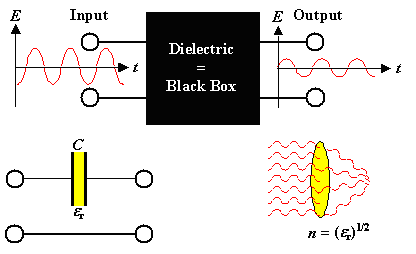 |
All polarization mechanisms respond to an electrical field by shifting masses
around. This means that masses must be accelerated and de-accelerated, and this will always take some time. So we must expect that the (mechanical) response to a field will depend on the frequency
n of the electrical field; on how often per second it changes its sign. |
|
 |
If the frequency is very large, no mechanical system will be able to follow. We thus expect
that at very large frequencies all polarization mechanisms will "die out",
i.e. there is no response to an extremely high frequency field. This means that the dielectric constant er
will approach 1 for n Þ
¥. |
 |
It is best to consider our dielectric now as a "black
box". A signal in the form of an alternating electrical field E
goes in at the input, and something comes out at the output, as shown below. Besides the Black Box scheme, two possible
real expressions of such an abstract system are shown: A parallel-plate capacitor containing a dielectric, and an optical
lens with an index of refraction
n = er. The input would be a simple alternating voltage in the capacitor
case, and a light wave in the lens case. |
| |
|
 |
As long as our system is linear ("twice the input Þ
twice the output), a sinewave going in will produce a sinewave coming out, i.e. the frequency does not change. |
|
 |
If a sinewave goes in, the output then can only be a sinewave with an amplitude and a phase
different from the input, as schematically shown above. |
|
 |
If a complicated signal goes in, we decompose it into its Fourier components, consider the
output for all frequencies separately, and then do a Fourier synthesis. |
 |
With complex notation, the input will be something like Ein = Ein
· exp(iwt); the output then will be Eout =
Eout · expi(wt + f).
|
|
 |
We just as well could write Eout = f(w)
· Ein with f(w) = complex number for a given
w or complex function of w. |
|  |
f(w) is what we are after. We call this function that relates the output of a dielectric
material to its input the dielectric function of the material.
As we will see, the dielectric function is a well-defined and very powerful entity for any material - even if we cannot
calculate it from scratch. We can however, calculate dielectric functions for some model materials, and that will give us
a very good idea of what it is all about. |
 |
Since the index of refraction
n
is directly given by er1/2
(assuming that the material has no magnetic properties), we have a first very general statement:
|
|
 |
There exist no microscopes with "optical" lenses for very high
frequencies of electrical fields, which means electromagnetic radiation in the deep ultraviolet
or soft X-rays. And indeed, there are no X-ray microscopes
with lenses1) (however, we still have mirrors!) because there are no materials
with er > 1 for the frequencies of X-rays. |
 |
Looking at the polarization mechanisms discussed, we see that there is a fundamental difference
in the dynamics of the mechanisms with regard to the response to changing forces: |
|
 |
In two cases (electron and ionic polarization),
the electrical field will try to change the distance between the charges involved. In response, there is a restoring force
that is (in our approximation) directly proportional to the separation distance of the dipole charges. We have, in mechanical
terms, an oscillator. |
|
 |
The characteristic property of any such oscillating system is the phenomena
of resonance at a specific frequency. |
|
 |
In the case of the orientation polarization, there is no direct mechanical
force that "pulls" the dipoles back to random orientation. Instead we have many statistical events, that respond
in their average results to the driving forces of electrical fields. |
|
 |
In other words, if a driving force is present, there is an equilibrium state with an (average) net dipole
moment. If the driving force were to disappear suddenly, the ensemble of dipoles will assume a new equilibrium state (random
distribution of the dipoles) within some characteristic time called relaxation time.
The process knows no resonance phenomena, it is characterized by its relaxation time
instead of a resonance frequency. |
 |
We thus have to consider just the two basic situations: Dipole
relaxation and dipole resonance. Every specific mechanism in real materials
will fit one of the two cases. |
| |
© H. Föll (Advanced Materials B, part 1 - script)
